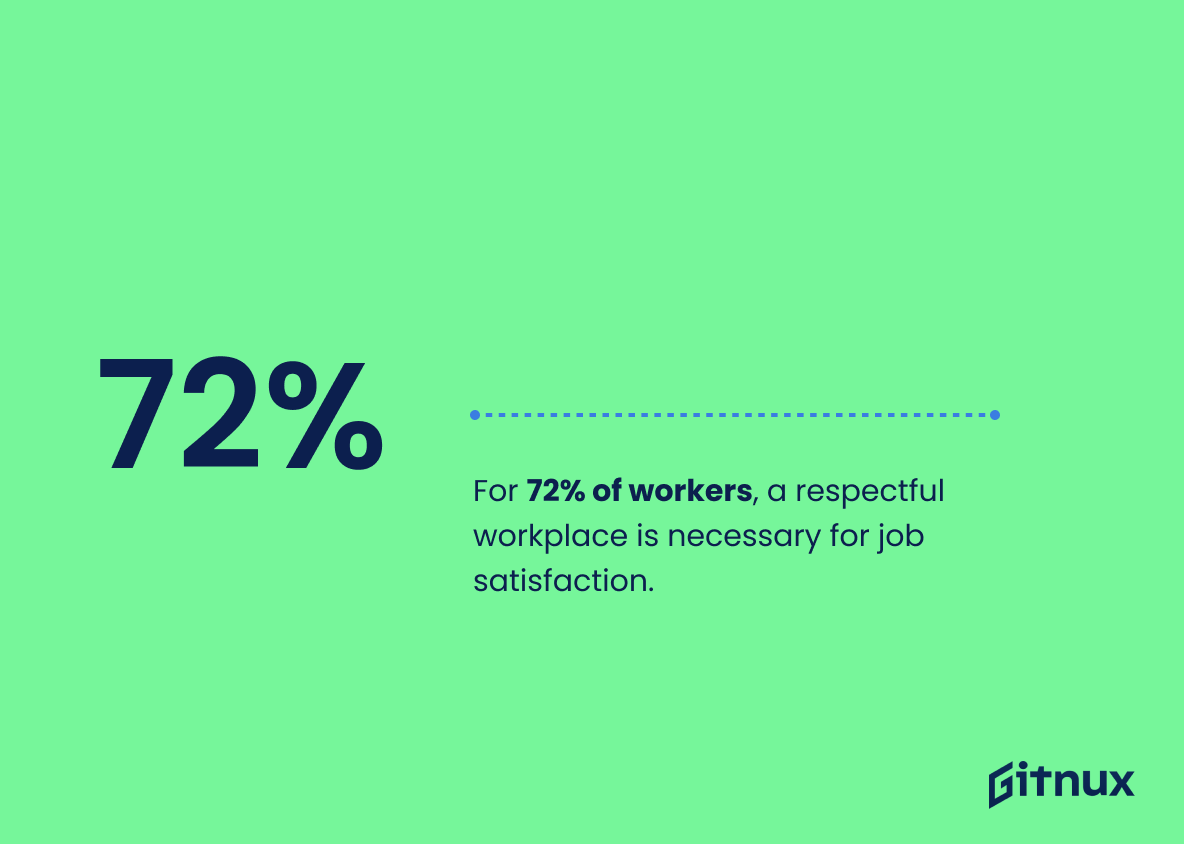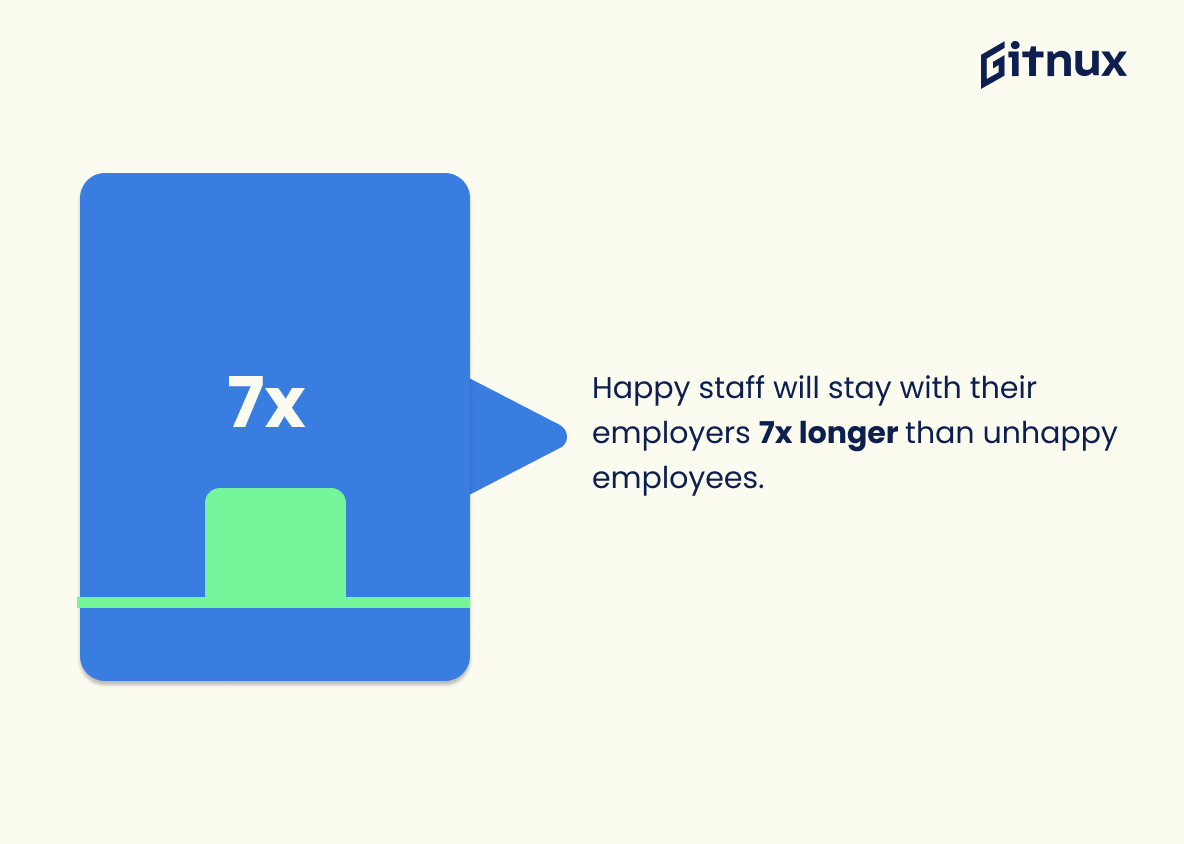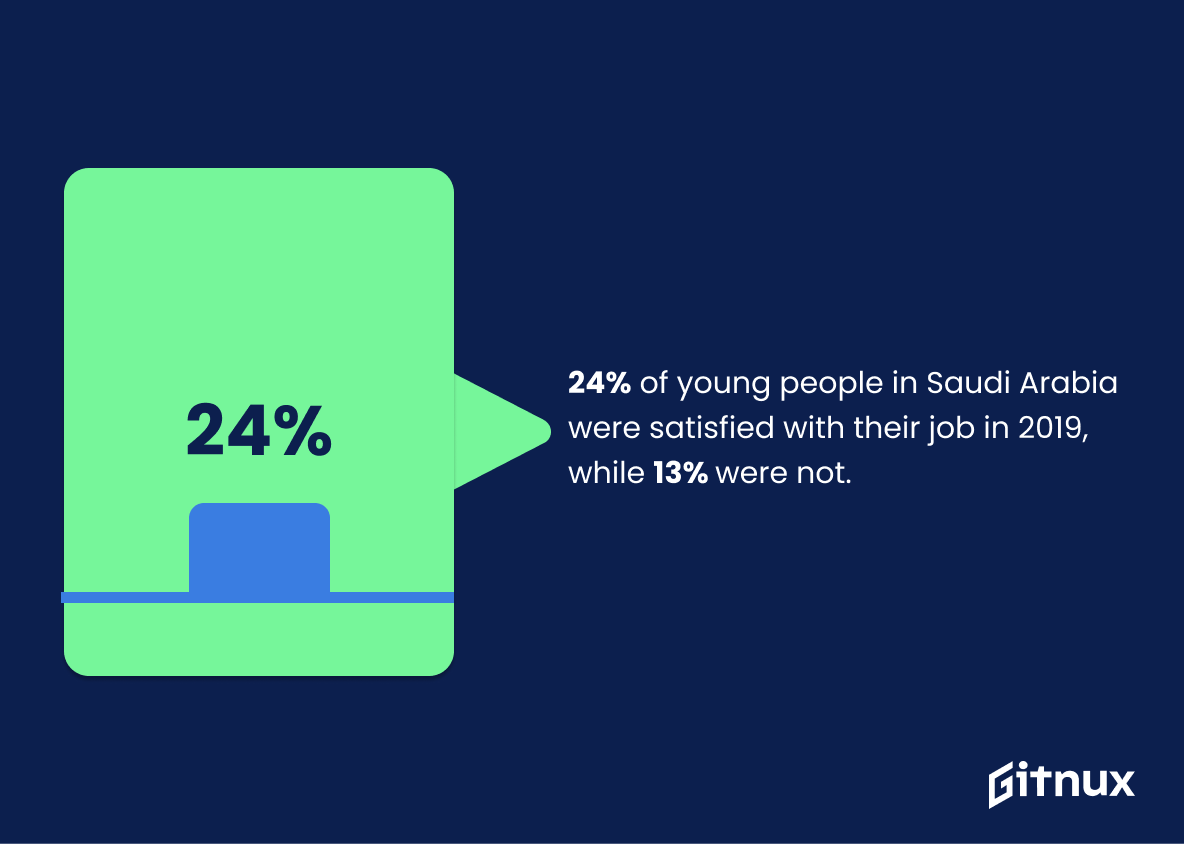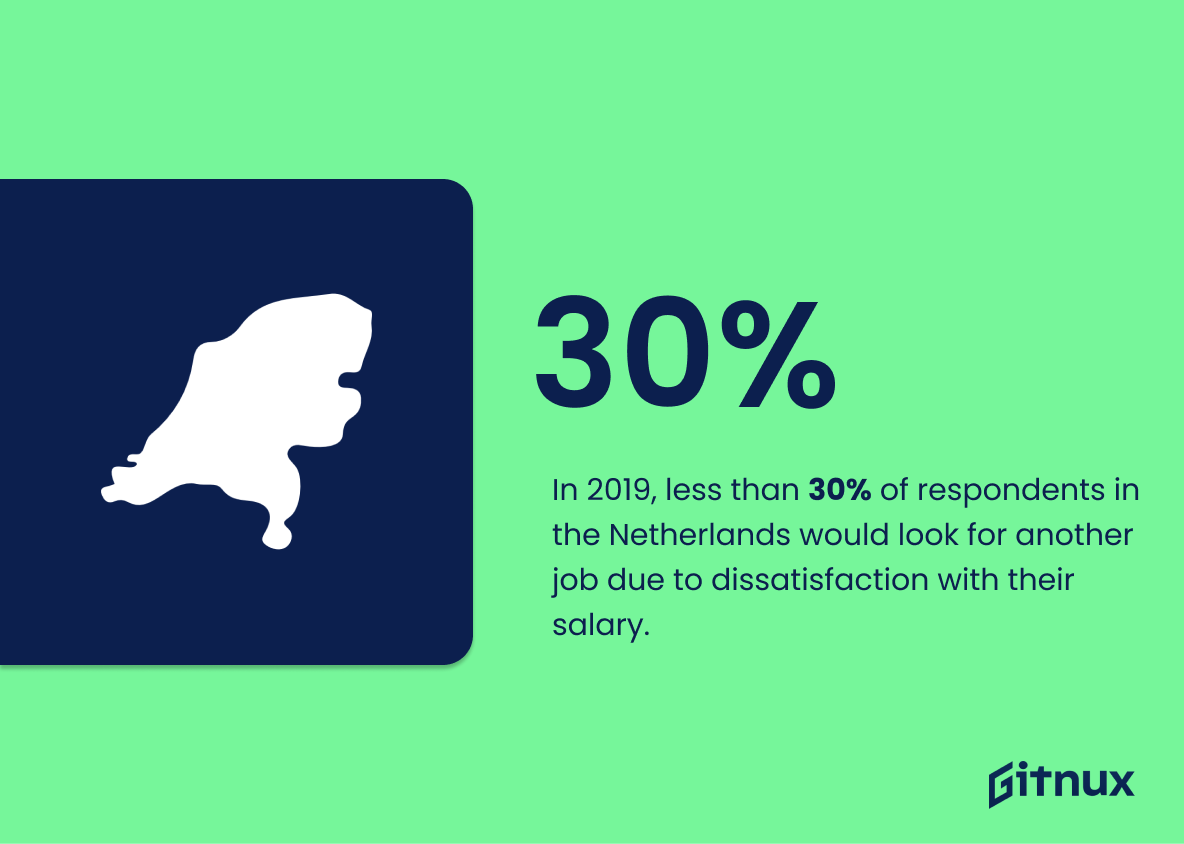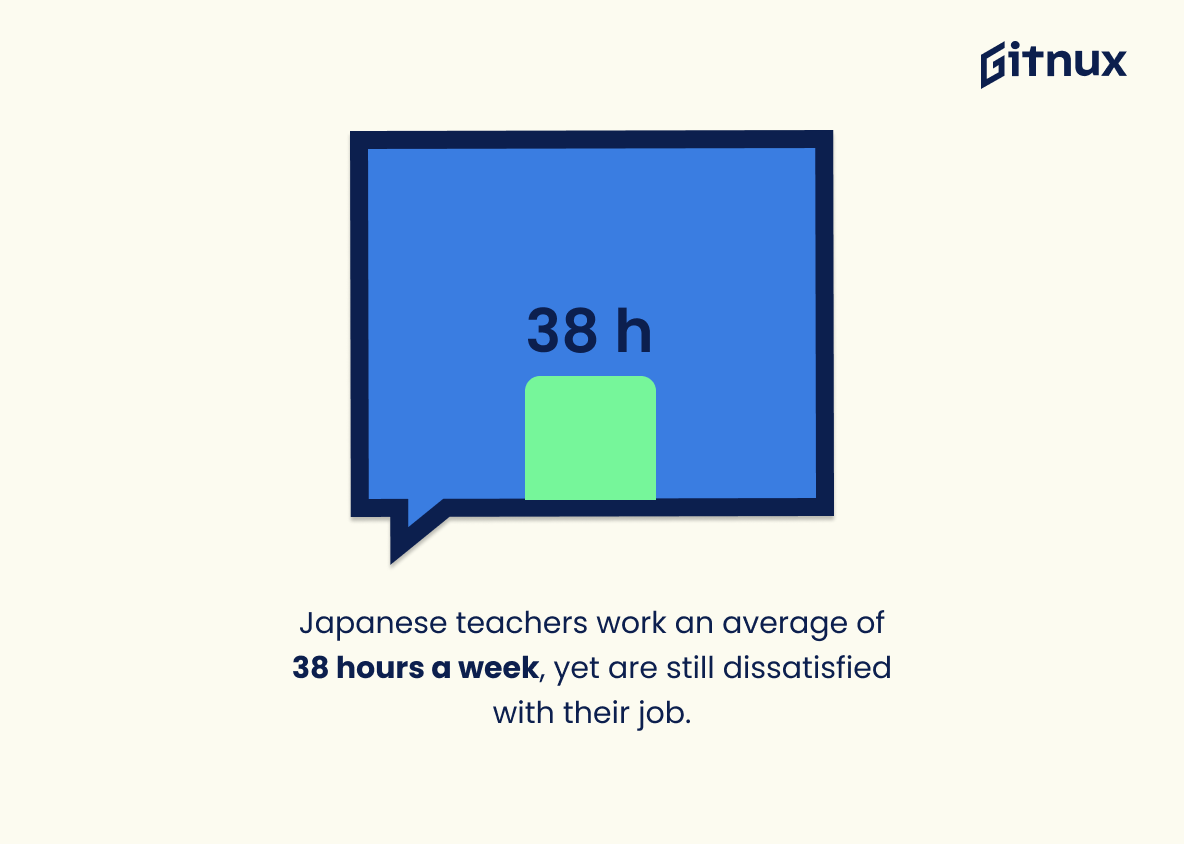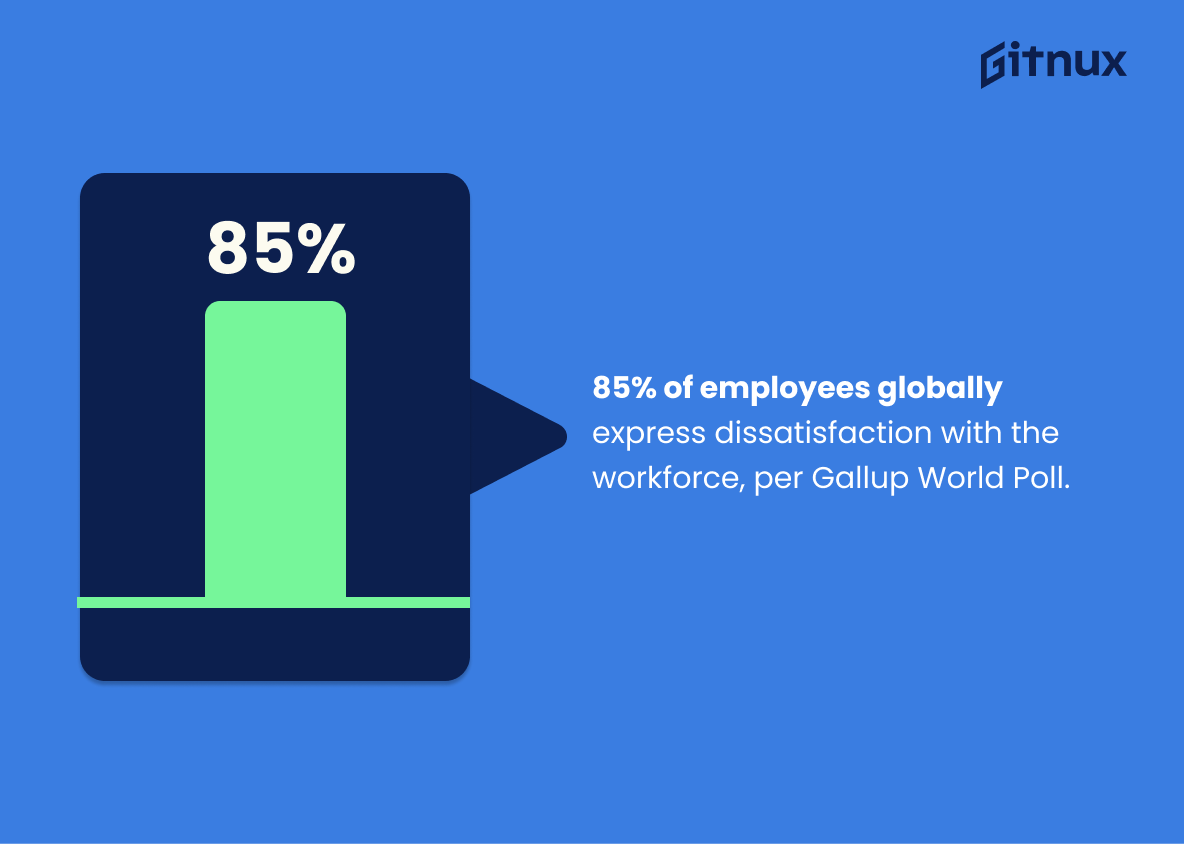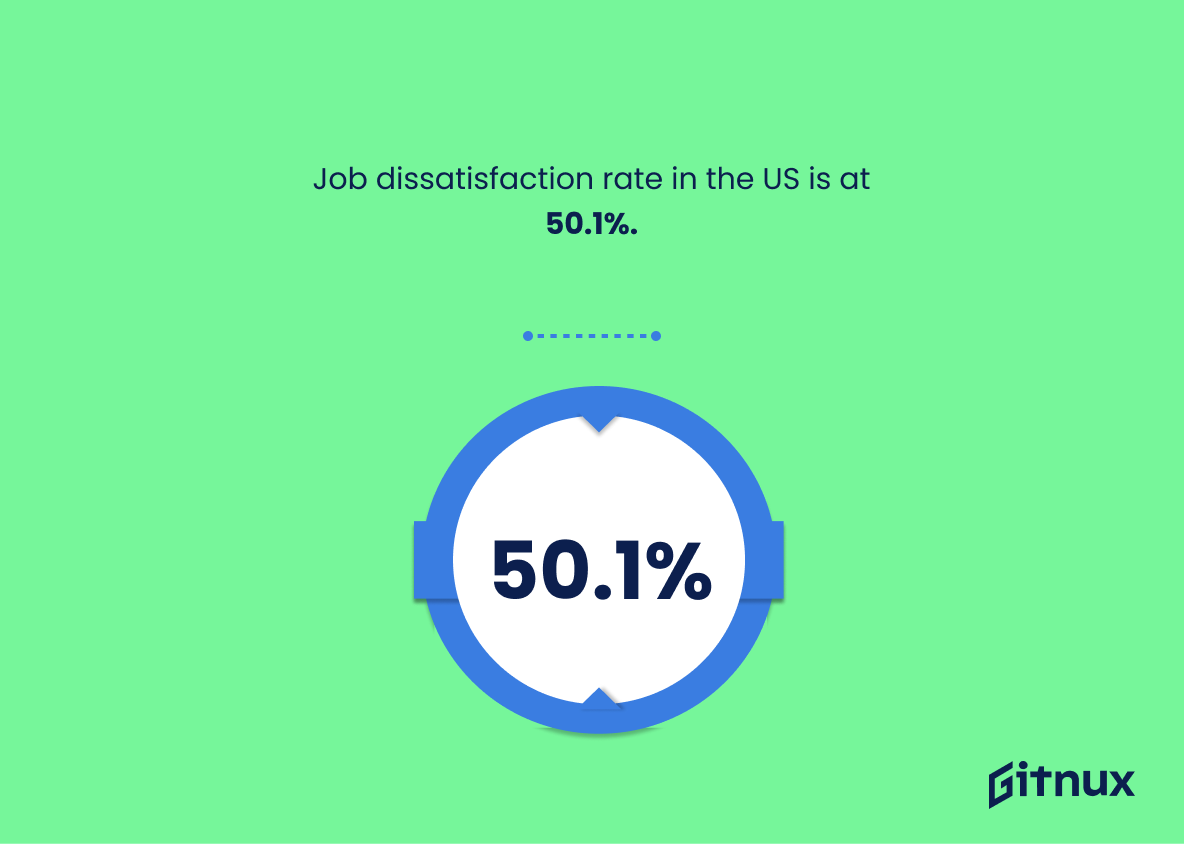Are you feeling unhappy at work? You’re not alone. Job dissatisfaction is a growing problem that affects millions of people around the world.
In this blog post, we’ll take a look at some of the latest job dissatisfaction statistics, and explore why so many people are unhappy in their current roles.
We’ll also discuss some potential solutions to this problem, and how employers can create a more positive work environment for their employees. So, if you’re feeling unhappy in your job, read on to find out more about job dissatisfaction statistics and what you can do to make a change.
Job Dissatisfaction: The Most Important Statistics
For 72% of workers, a respectful workplace is necessary for job satisfaction.
16% of people would quit their job after experiencing a colleague crisis.
Job Dissatisfaction: Statistics Overview
In 2022, 60% of people reported being emotionally detached at work, and 19% reported being miserable.
It suggests that a large percentage of people are feeling disconnected and unhappy in their jobs. This can lead to low morale, poor job performance, and a lack of engagement. Ultimately, this can lead to a decrease in productivity, an increase in absenteeism, and a decrease in job satisfaction. Understanding this statistic can help employers identify and address any potential issues, as well as take proactive steps to ensure that all employees are engaged, supported, and satisfied in their roles.
In the US, 50% of workers reported feeling stressed at their jobs on a daily basis, 41% as being worried, 22% as sad, and 18% as angry.
Job dissatisfaction is a widespread issue in the US. High levels of stress, worry, sadness, and anger suggest that many workers are not satisfied with their jobs, which can have long-term consequences for both the employees and their employers. Employers should take note of these numbers and address any underlying issues that may be causing their employees to feel so dissatisfied.
For 72% of workers, a respectful workplace is necessary for job satisfaction.
It is really important to create a respectful workplace for employees. If a workplace is not respectful, it can lead to job dissatisfaction, which can have a negative impact on productivity, morale, and overall job performance. A respectful workplace can foster a sense of trust and support among employees, create a sense of belonging, and increase job satisfaction. It is therefore essential for employers to prioritize creating a respectful workplace in order to retain their employees and ensure job satisfaction.
Happy staff will stay with their employers 7x longer than unhappy employees.
Job dissatisfaction can have a serious impact on the longevity of employees. Employers should make sure to create a positive and supportive work environment to ensure that their staff remain satisfied and committed to their work. Unhappy staff are more likely to leave their employers, which can be costly and damaging to the business.
48% of female professionals and 39% of male professionals in India would remain in their current job if they had a higher salary.
This statistic shows that salary is a major factor in employee retention. If employers are able to offer higher salaries, they may be able to reduce the rate of job dissatisfaction and turnover.
86% of surveyed employees in China would ask for a higher salary or a promotion in the next year, but would not leave their job or switch employers.
It shows that despite the desire for higher salaries or promotions. Chinese employees are still content with their current job and do not feel the need to switch employers. This suggests that job dissatisfaction is not as high as it could be, and that employees are content with their current job.
21% of foreign nationals in Japan were not satisfied with the pace of promotion and 1/5 of jobbers were disappointed with the housing and living support they received, showing a high rate of job dissatisfaction.
There is a high rate of job dissatisfaction among foreign nationals in Japan, which can lead to a lack of motivation, a decrease in productivity, and a decrease in job satisfaction. This can have a negative impact on the overall economy and can lead to a decrease in foreign investment.
1/3 of foreign workers in Japan felt lonely due to job dissatisfaction.
Employers should provide foreign workers with better job satisfaction in order to reduce feelings of loneliness. Part-time work can help to reduce feelings of loneliness, but the root cause of the problem is the workplace environment. This statistic can be used to inform employers on how to better support foreign workers in order to reduce feelings of loneliness and improve job satisfaction.
24% of young people in Saudi Arabia were satisfied with their job in 2019, while 13% were not.
Job dissatisfaction is a real issue among young adults in Saudi Arabia. It is important to understand the level of job dissatisfaction in order to address the issue and create policies that will help young adults find satisfaction in their jobs.
16% of people would quit their job after experiencing a colleague crisis.
A significant portion of people would be willing to leave their job due to a negative experience with colleagues. Indicating that workplace relationships can play a major role in job satisfaction.
In 2019, less than 30% of respondents in the Netherlands would look for another job due to dissatisfaction with their salary.
Job dissatisfaction due to salary is a major factor in the decision to look for a new job. This statistic can help inform employers and policymakers of the need to ensure that salaries are fair and competitive in order to retain employees.
Japanese teachers work an average of 38 hours a week, yet are still dissatisfied with their job.
It shows that even when a job is considered to be desirable and stable, it does not necessarily mean that the job is satisfying. This highlights the importance of considering job satisfaction when evaluating job opportunities.
33% of Chinese responders believe that having a meaningful job would make them happier, compared to 80% of responders overall.
Having a meaningful job is a key factor in overall happiness and mental health. This highlights the need for employers to ensure that their employees are engaged and fulfilled in their roles.
See our article about Night Shift Statistics
Supplementary Statistics
85% of employees are unhappy with the workforce, affecting their job dissatisfaction, Source: Gallup World Poll;
The fact that such a large percentage of employees are unhappy with their jobs is a clear sign that something needs to be done to improve the situation. This statistic is an important piece of evidence that should not be overlooked when discussing job dissatisfaction statistics.
Job dissatisfaction rate in the US is at 50.1%,
It paints a picture of a workforce that is struggling to find fulfillment in their work, and it serves as a call to action for employers to take steps to improve the job satisfaction of their employees.
76% of employees are stressed due to their job dissatisfaction,
This serves as a powerful indicator of the need for employers to take steps to ensure their employees are satisfied with their jobs. It also highlights the importance of providing employees with the resources and support they need to be successful in their roles.
3 in 4 employees consider their jobs to be significant sources of job dissatisfaction, including mental concerns,
A large majority of employees are not content with their jobs, and that mental concerns are a major factor in this dissatisfaction. This is an important point to consider when discussing job dissatisfaction, as it emphasizes the need for employers to take steps to ensure their employees are satisfied and mentally healthy.
43% of employees plan to quit their jobs within the next two years due to job dissatisfaction,
Employers need to take proactive steps to ensure their employees are satisfied with their jobs, or risk losing a significant portion of their workforce in the near future.
35% of employees consider lack of career advancement opportunities as a key factor of job dissatisfaction,
It suggests that a significant portion of employees feel that their current job does not provide them with the opportunity to progress in their career, leading to dissatisfaction. This highlights the need for employers to provide employees with the opportunity to develop and grow in their roles, in order to ensure job satisfaction.
80% of employees who don’t feel valued in their current role are likely to quit due to job dissatisfaction,
This highlights the fact that when employees don’t feel appreciated, they are more likely to become dissatisfied with their job and eventually leave. This is a significant issue that employers should be aware of, as it can lead to a high turnover rate and a decrease in productivity. Therefore, this statistic serves as a warning to employers to ensure that their employees feel valued and appreciated in order to maintain job satisfaction and a healthy work environment.
A 10% increase in job satisfaction boosts overall life satisfaction by 1%,
Job dissatisfaction can have a ripple effect, impacting not only an individual’s work life, but also their overall life satisfaction. This statistic serves as a reminder that job dissatisfaction can have a profound effect on an individual’s overall wellbeing, and should not be taken lightly.
23% of employees cite feeling undervalued as the primary reason for job dissatisfaction,
Employers need to ensure that their employees feel valued and appreciated, as this is a key factor in job satisfaction. It also serves as a warning that failing to do so can lead to a decrease in morale and productivity, as well as an increase in job dissatisfaction.
48% of employees would leave their jobs for another position that they believe is a better fit for their skills,
It suggests that nearly half of the workforce is not content with their current positions and are actively seeking out other opportunities that better suit their skills. This speaks to the need for employers to ensure that their employees are satisfied with their roles and that their skills are being utilized to their fullest potential.
25% of employees feel disengaged within their work environment, contributing to job dissatisfaction,
A quarter of employees are feeling disengaged and dissatisfied with their work environment, which can have a detrimental effect on morale, productivity, and overall job satisfaction. It is a clear indication that employers need to take steps to ensure that their employees are engaged and satisfied with their work.
66% of employees would not recommend their workplaces to others due to job dissatisfaction,
This paints a picture of a workforce that is largely unhappy with their current employment situation, and it serves as a warning to employers that they need to take steps to improve the working environment for their employees. It also serves as a reminder to job seekers that they should be mindful of the potential for job dissatisfaction when considering a new job.
30% of employees experience job dissatisfaction due to unclear expectations from their managers,
Without clear expectations, employees can become frustrated and dissatisfied with their job, leading to a decrease in productivity and morale. It is essential for managers to ensure that their employees understand their roles and responsibilities, as well as the expectations of their job, in order to create a positive and productive work environment.
59% of employees feel that their companies do not prioritize employees’ best interests, leading to job dissatisfaction,
This statistic is a stark reminder of the reality that many employees face: their companies are not putting their best interests first. It paints a picture of a workplace where employees feel neglected and unappreciated, leading to job dissatisfaction. This statistic is a powerful indicator of the need for companies to prioritize their employees’ well-being and satisfaction in order to create a healthy and productive work environment.
45% of employees report that their jobs negatively impact their physical health due to job dissatisfaction,
It highlights the importance of creating a workplace environment that is conducive to employee satisfaction and well-being. It also serves as a warning to employers that job dissatisfaction can have serious consequences for their employees’ physical health.
Only 37% of employees feel their workplaces successfully support their mental health or happiness, influencing job dissatisfaction,
Employers should prioritize the mental wellbeing of their employees, as it is clear that a lack of support in this area can have a significant impact on job satisfaction.
60% of employees report long hours as a key factor of job dissatisfaction,
Most employees are feeling the strain of long hours, which can lead to a decrease in morale and productivity. This is an important factor to consider when discussing job dissatisfaction, as it can have a significant impact on the overall satisfaction of employees.
Conclusion
In conclusion, job dissatisfaction is a real problem that affects millions of people around the world. It can have a negative impact on employee morale, productivity, and overall job satisfaction.
By understanding the statistics and the causes of job dissatisfaction, employers can take steps to improve the work environment and create a more positive work experience for their employees. With the right strategies in place, employers can help reduce job dissatisfaction and create a more positive work environment for everyone.
References
https://www.statista.com/statistics/1324293/india-likelihood-of-professionals-staying-in-their-current-job-for-higher-compensation-by-gender/
https://www.statista.com/statistics/1327581/china-actions-to-be-taken-by-employees-within-one-year/
https://www.statista.com/statistics/1112456/japan-disappointing-working-conditions-according-to-foreign-workers-by-type-of-employee/
https://www.statista.com/statistics/1112491/japan-loneliness-foreign-workers-by-type-of-employee/
https://www.statista.com/statistics/1121931/saudi-arabia-youth-satisfaction-with-current-job/
https://www.statista.com/statistics/632218/satisfaction-with-money-and-job-young-adults-usa-by-gender/
https://www.statista.com/statistics/977724/colleague-crisis-at-work-uk/
https://www.statista.com/statistics/695422/most-important-reasons-to-search-for-a-new-job-in-the-netherlands/
https://www.statista.com/statistics/647601/japan-educational-establishment-teacher-number-by-type/
https://www.statista.com/statistics/1063544/china-having-meaningful-job-as-happiness-source/
https://www.cnbc.com/2022/08/12/job-unhappiness-is-at-a-staggering-all-time-high-according-to-gallup.html
https://www.globoforce.com
https://www.pnas.org
https://www.conference-board.org
https://economictimes.indiatimes.com
https://www.gallup.com
https://www.monster.com
https://www.tinypulse.com
https://www.roberthalf.com
https://www.randstadusa.com
https://www.mentalhealthamerica.net
https://www.udemy.com
ZipDo, cited June 2023: Job Dissatisfaction Statistics


